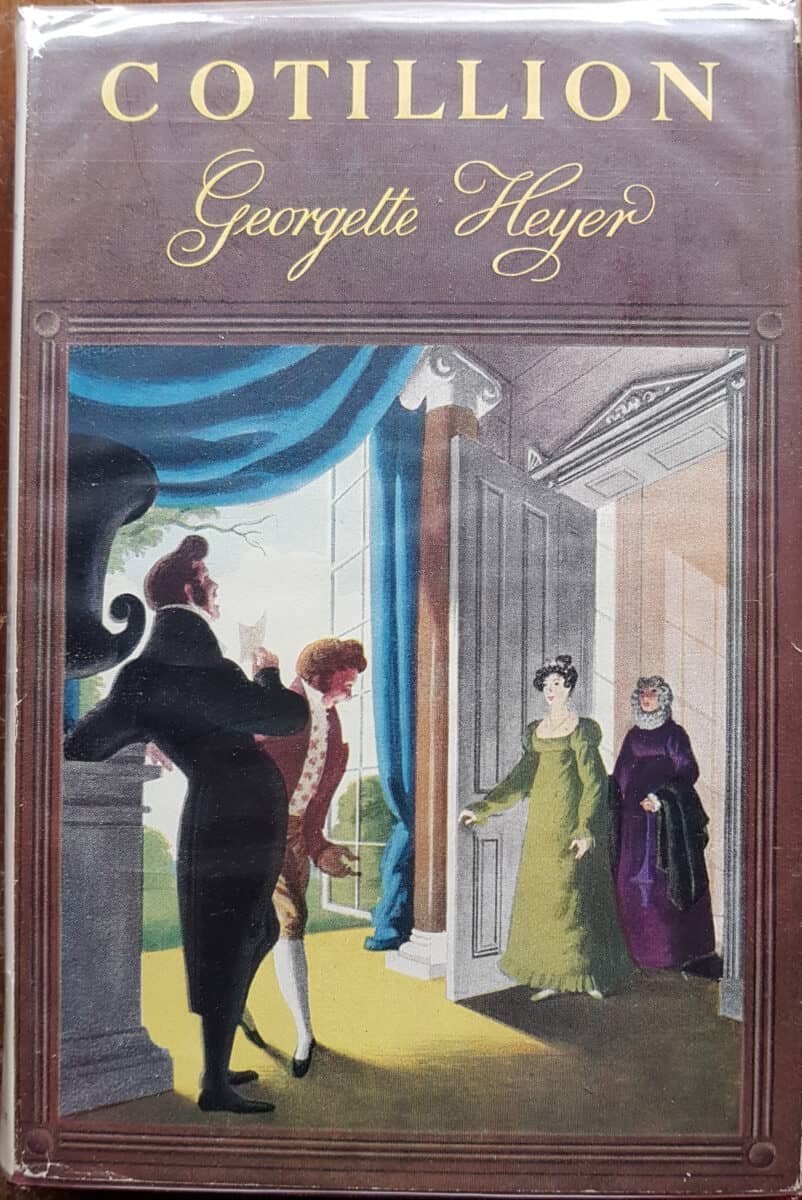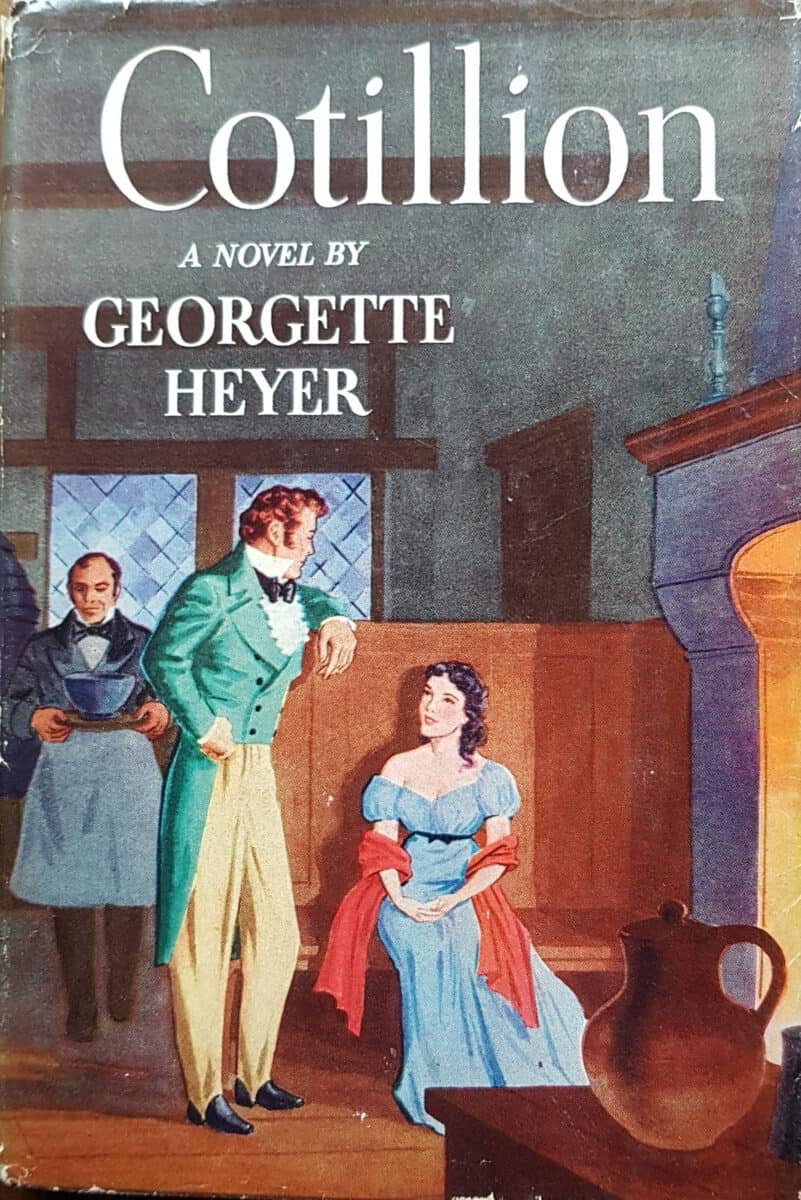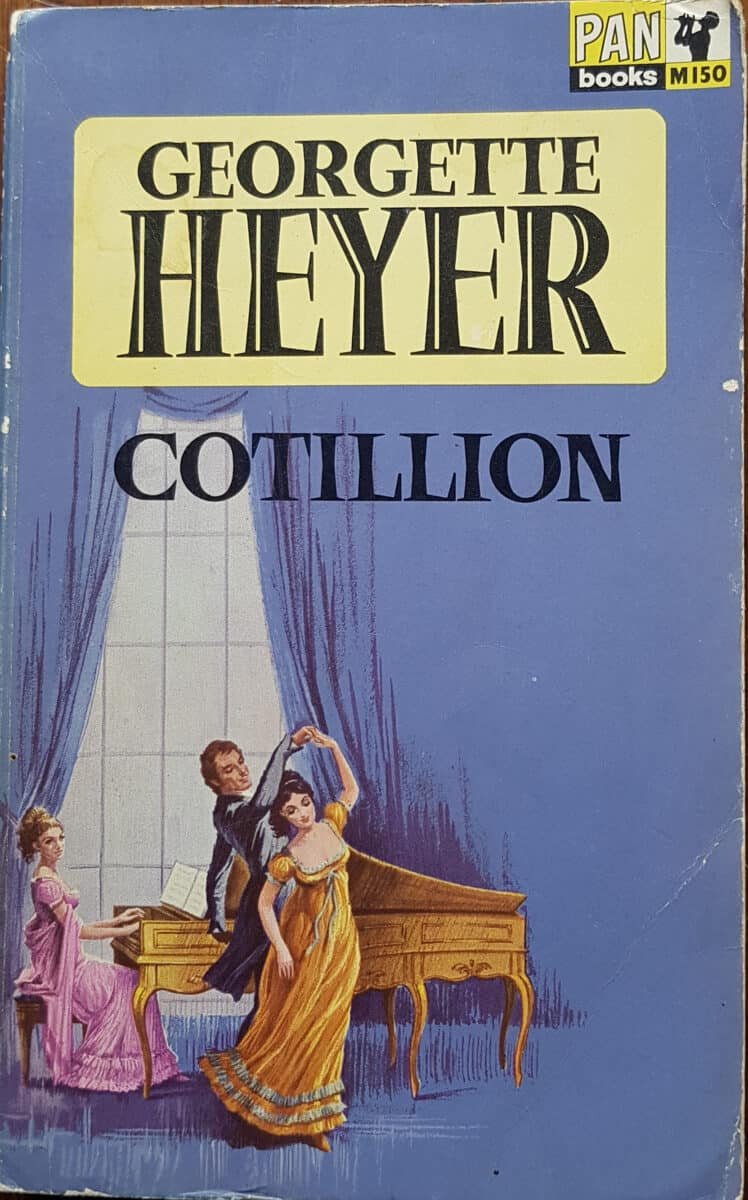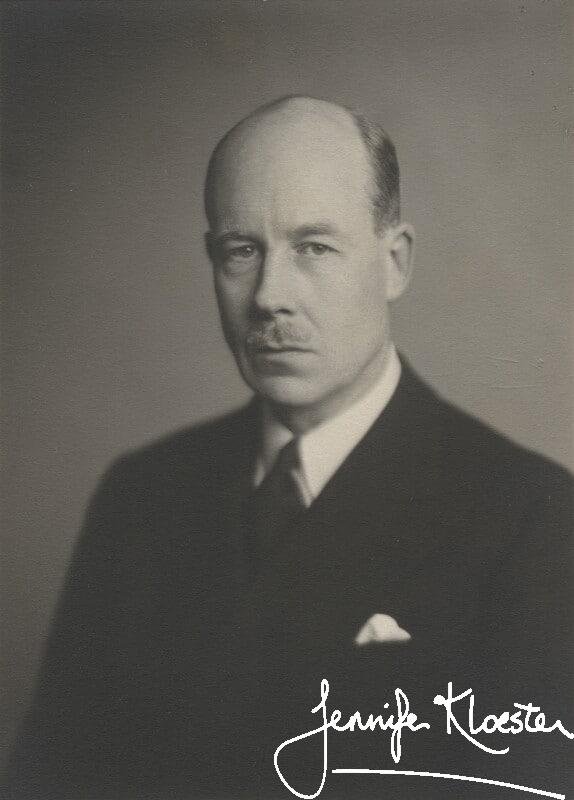“So I’ve settled that one of you shall have her, and my fortune into the bargain.”
Great-Uncle Matthew Penicuik.
An outrageous scenario
The miserly Mr Pencuik is guardian to the orphaned Kitty Charing and he has decided that his ward shall only inherit his fortune if she marries one of his four great-nephews. This outrageous scenario prompts four very different reactions from Kitty’s potential bridegrooms: Hugh, the rather pompous rector, is willing to marry his cousin; Dolphington, the “impoverished Irish Earl”, is reluctant but compelled by his overbearing mother to offer for Kitty; Jack, that handsome, dashing blade intends to win the fortune but refuses to be pushed into marriage; and Freddy, whose family thinks him a fool, is oblivious to his great-uncle’s plan and arrives late on the scene. Freddy is the kindest of Kitty’s likely suitors and so, when his country cousin begs him to pretend to be engaged to her so that she may escape from her penny-pinching old guardian and enjoy a month in London, Freddy reluctantly agrees. Unbeknowns to Freddy, however, Kitty has her sights set on Jack, but Heyer’s love of comic irony means that her heroine’s path to true love is anything but smooth.

“Inspired”
So begins the book that would become Cotillion – one of Georgette Heyer’s most delightful novels. She began writing the book early in February 1952 and finished it three months later. It was a story she had been wanting to write for some years – ever since she had finished Friday’s Child almost ten years earlier in 1943. That novel had featured the foolish, feather-brained, but very funny, Ferdy Fakenham, one of Georgette’s favourites among her many comic characters. Many years after writing Friday’s Child Georgette told a friend that she still considered that novel: “the best I ever wrote. Perhaps because it wrote itself. Perhaps because it contains Ferdy Fakenham, who not only stole it, but inspired me, years later, to write Cotillion.” In the new novel Ferdy was originally “Felix” but “turned out to be Freddy”. Freddy is a pink of the ton, warm-hearted, genial and, at first glance, not very bright. But first glances can be misleading and Georgette took great pleasure in writing a character who would never be classified as a typical Heyer-hero. Years later she would describe these men as either “suave, well-dressed, rich, and a famous whip, according to Model No.1; or, Model No. 2, the brusque, savage sort, with a foul temper.” [GH to Max Reinhardt letter 7 April 1966] Though he is always well-dressed, Freddy is neither a Model 1 nor a Model 2, but an entirely new kind of hero. Part of the fun of the novel lies in just how long it takes for Kitty (and many readers) to realise this fact.

The Honourable Frederick Standen
The Honourable Frederick Standen has long been a prime favourite among Heyer readers. Freddy is neither a Corinthian nor a Nonesuch, but rather a Pink of the Ton. Though fastidious about his dress, at first there seems not much to Freddy whose “countenance was unarresting, but amiable; and a certain vagueness characterized his demeanour.” It is a deliciously deceptive introduction. Freddy soon becomes involved in Kitty’s affairs and gradually a new Freddy emerges to the fascination of both the reader and Freddy’s father, Lord Legerwood. Though he appears only a few times in the novel, Lord Legerwood is one of Georgette’s most deftly created minor characters and a superb example of her skill as a writer. His encounters with his son, the way he looks and speaks, and the things he says are remarkably memorable for one with such a small part to play in the story. She throughly enjoyed writing the novel and even returned to her old habit of writng out some passages for her publisher – something she had often done in the 1930s when enthused about a new book.
my Inestimable Spouse declares it is The Real McCoy. I have certainly doubled him up once or twice, with a very choice number, called Lord Dolphington, and described by one of his cousins as “queer in his attic.” — ‘ “I ain’t clever, like you fellows, but when people say things to me once or twice I can remember them.” He observed that this simple declaration of his powers had bereft his cousin of words, and retired again, mildly pleased, into his book …
There is also a sentimental governess.– ‘ “Oh!” cried Miss Fishguard, clasping her hands over her emaciated bosom, and blushing with emotion. “Only think, Mr Frederick! – One touch to her hand, and one word in her ear, When they reached the hall-door, and the charger was near; So light to the croupe the fair lady he swung, So light to the saddle before her he sprung! And then, you know, he rode off with fair Ellen, and the lost bride of Netherby ne’er did they see! So daring in love; and so dauntless in war. Have you e’er heard the like of young Lochinvar?”
Sounds like a curst rum touch,” said Freddy disapprovingly.’
Georgette Heyer to Louisa Callender, letter, 23 February 1952

“A riot of absurdity”
In March 1952, Georgette sent Louisa Callender an outline of the new novel. She was almost halfway through the book but obviously knew exactly what was to come in terms of the plot. She had written about 50,000 words and made sure to explain to Louisa that the synopsis did not really convey exactly what she meant to do with the plotlines. This was because she couldn’t insert explanations into the synopsis along the lines of “This sounds corny, but wait till you see how I mean to handle it!”. She had high hopes that if the novel worked out as she had planned that it would be “a riot of absurdity”.
From Quadrille to Chicken-Hazard to Cotillion
At first, Georgette thought to call her new novel, Quadrille, after the eighteenth-century dance so popular during the Regency. A month later she told Louisa Callender at Heinemann that she intended calling it Chicken-Hazard – adding the tongue-in-cheek rider: “unless Frere violently objects, and quite probably even if he does, because what does he know about anything, anyway?” Both Quadrille and Cotillion are dances in which four couples perform a series of intricate steps – an apt reflection of the intricate nature of Georgette’s plot. The title, Chicken-Hazard is far less relevant to her story. Hazard is a dice game reputed to have been played by the Crusaders in the 12th century while laying siege to the Arabian Castle of Azart or Hazart. Mentioned in Chaucer, it became hugely popular in Europe in the 17th and 18th centuries and when exported to America developed into the dice game known as “craps”. Chicken-Hazard refers to the same dice game only played for small stakes – hence the appellation “chicken”. Fortunately, Georgette soon thought better of the title and changed it to Cotillion.

Four Couples in an intricate plot
According to Webster’s dictionary, the Cotillion dance is “an elaborate and complicated dance … marked by the giving of favors and frequent changing of partners”. It is also a dance performed by four couples. In her novel, Cotillion, Georgette created an intricate set of movements performed by four couples. Though they are not all of them main characters, the eight players in the novel each have a vital role in the story. As in the dance, they weave in an out of each others’ lives, turning this way and that, passing from one to another, changing hands and direction until at last the dance – and the story – is done. As Georgette herself described it, “the whole thing is a sort of set-to-partners”. Kitty believes she is to partner Jack, but ends up spending more time with Freddy; simple-minded Lord Dolphington wishes to partner plain, pragmatic Hannah Plymstock; beautiful Olivia Broughty (whose mother wishes to sell her to the highest bidder), wants only to partner Kitty’s cousin, the handsome and romantic Chevalier d’Evron; and, in a neat twist at the end of the novel, Kitty’s ill-tempered, miserly guardian, Mr Penicuik, finds himself partnering Kitty’s kind and sentimental governess, Miss Fishguard. Complications abound throughout the novel but Heyer proves herself a master of the dance and achieves in Cotillion one of her cleverest and most unexpected stories. As Heyer herself explained in a synopsis for the second half of the book:
It would take too long to describe the intricacies of the second half, nor should I care to be bound down to a hard and fast pattern, for at any moment a new and still more absurd situation might present itself to me. In broad outline, Dolphington, supposed by his outrageous mother to be engaged in a plot of her devising to force Kitty into marriage with himself, marries, with the maximum amount of help from Kitty, Hannah Plymstock, a plain young woman of no birth or fortune but much hard sense; Jack, with every intention of marrying Kitty in his own time, gets neither her nor the beautiful Olivia, towards whom his intentions are strictly dishonourable. Olivia, urged by her mother to marry a rich and repulsive old roué, flies to France with the Chevalier – an adventurer and a gamester, whose schemes are overset partly by his falling in love with Olivia, and partly by Freddy, whose way of getting rid of Kitty’s embarrassing cousin is unorthodox but eminently practical. Mr Penicuik upsets Jack’s calculations by deciding to marry Miss Fishguard. Freddy marries Kitty.
Georgette Heyer to Louisa Callender, synopsis, March 1952.
And what of Jack?
And what of Jack? Little by little the contrast between Jack and Freddy becomes ever more apparent to Kitty. The Pink of the Ton comes into his own and Kitty gradually learns (as Heyer knows only too well) that Freddy would make a much better husband than handsome Jack Westruther. Georgette was often surprised by the number of her fans who wrote to her about wanting to find a man like the heroes in her novels. Georgette often observed that most Heyer heroes would make dreadful husbands and wondered at those readers who apparently swooned over them. Even so, Jack is not a intended to be a villain. As Georgette herself said in a message to Miss Sutherland, the editor at Woman’s Journal: “And don’t let her run away with the idea that Jack is a villain: there isn’t a villain.”
It is not the heroic Jack who always comes up to scratch in any impasses, but the foolish Freddy. He and Kitty grow closer and closer together until, at the end, after a grand imbroglio in Hugh’s rectory, it dawns on them that they were made for each other.’
Georgette Heyer to Louisa Callender, letter, March 1952.

Copyright The National Portrait Gallery, used with permission
“To Gerald”
Georgette finished writing Cotillion at the end of April 1952, just three months after starting it. Heinemann scheduled the novel for publication in January 1953 to allow time for it to appear in serial form in Woman’s Journal and the Australian Woman’s Day and other popular magazines. On 24 October 1952, Georgette’s great friend, Carola Oman, rang to say that her beloved husband, Gerald Lenanton, had died suddenly. He was only 56 and his death was a great blow to them all. Georgette had dedicated Cotillion to Gerald and told him that it was “his” book. He had read the book in proof while in the London Clinic only two months earlier and had greatly enjoyed it. Georgette was shattered by his death, telling Frere that “Gerald was one of the nicest people we ever knew, and we shall miss him terribly.” She also felt terrible for Carola. She and Gerald had celebrated their thirtieth wedding anniversary in April and were devoted to each other. Cotillion was Georgette’s small tribute to a beloved and valued friend.
Gerald Foy Ray Lenanton was still at WInchester when war broke out in 1914. amd early in the next year entered the Royal Military Academy. After receiving a commission in the Royal Artillery he saw active service with the R.H.A., rising to the rank of captain in 1918. After general demobilization he went up to Christ Church. Oxford cast its spell over him in a marked way, so that though he spent the rest of his life in business, he carried with him an atmosphere of leisure and culture which, though it made acquaintance with him a keen pleasure, yet in no way detracted from his efficiency as a business man. He had married in 1922 Carola, daughter of Sir Charles Oman, this reinforcing his ties with Oxford.
Obituary, “Sir Gerald Lenanton”, The Times, 24 October 1952.

As she came to the end (one of her best) of her 39th novel, Georgette wrote ( a little tongue-in-cheek) to Louisa about Cotillion: “It is Terrific…It is a classic Heyer. It is EXACTLY what the Fans like. It is in my best manner.” She was right. The novel was an instant success, selling 45,000 copies in its first few months of publication.





4 thoughts on “Cotillion – a delightful dance”
Cotillion is a much more suitable title than Quadrille. That latter dance is quite strictly regimented, with all couples ending up as they began, and no chances for fancy steps, general frivolity or stealing partners.
Did Georgette know the difference? We don’t know if she herself was an experienced dancer.
Hi Julia
Yes, I suspect she did know the difference. I love that she devised the novel as a kind of dance with the four couples all weaving in and out and finally ending up where they belong. She was such a clever writer. Are you a Regency dancer? I’ve done a little bit and am in admiration of those who can master the moves!
Freddy is a delight. I’d love to find someone just like him for my daughter.
I thought I was the only one who loved Freddy’s interaction with his father. It was so short, so few words, but really lovely.
She was a master.
I adore Freddy and Heyer’s creation of Lord Legerwood is, as you say, from the pen of a master! He is only in the novel a few times but he is SO real and I think most readers love him! Thanks for posting and I agree with wishing for someone like Freddy for your daughter (and mine).